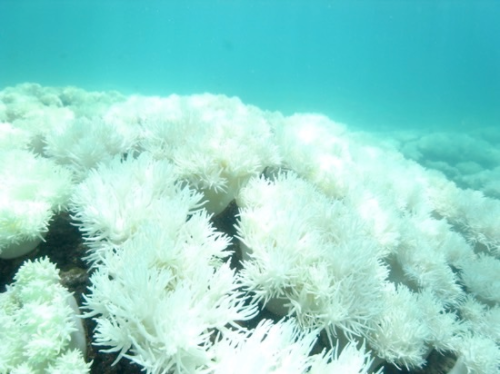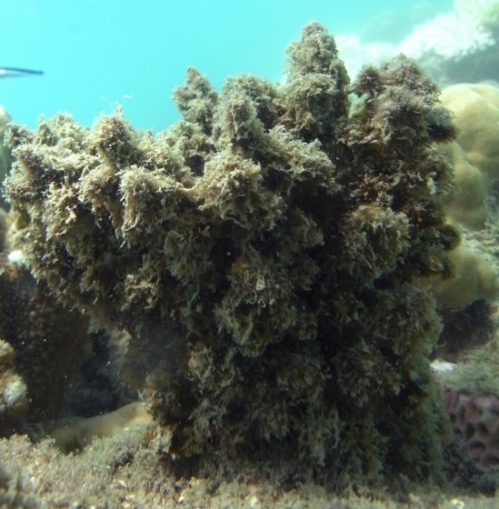OPINION: Vested interests playing down life-denying reef event
CRISPIN HULL

THIS is not a crime against humanity. This is a crime by humanity. We have sentenced to death the largest living thing on the planet – the Great Barrier Reef. The sentence is being carried out slowly and painfully before our eyes.
Yes, the catastrophic bleaching of the 2015-16 summer got some media attention and got a bit of playing down, too. But in some ways the 2016-17 summer has been worse for the reef. Not in what happened. But in what did not happen.
There has been no discernable recovery from 2015-16 and whole new areas have now been bleached. Moreover, soft corals are succumbing in greater numbers.
I am not a scientist and not a Great Barrier Reef expert. As a journalist, sailor and frequent diver and snorkeler, I can only report what I see and combine it with what I read and who I talk to.
There have been several reasons for the underplaying of this gruesome life-denying event.
It is no longer news. “Yep, we have done coral bleaching on the reef. Next.”
Tourists are taken to places least affected so they feel the operator has given the tourist value for money. So the word goes south: “The reef looked okay to me.”
Vested interests play it down. Businesses that rely on the reef want business as usual. Politicians do not want to be blamed for their criminal inactivity.
People who go to the reef every day become like frogs in water that is slowly brought to the boil. An apt metaphor in this case. They do not notice the change until it is too late.

And scientists have a professional requirement to do their work quietly and dispassionately.
Ultimately, though, the 2300 km reef is worth $6.5 billion a year to the Australian economy (nearly all from tourism) and provides employment for 70,000 people in tourism, aquaculture, fishing and so on, mostly in tourism that is directly dependent on a healthy reef. We should be doing everything possible even if our action of climate change can only be a small contribution pat of the needed global action.
Given what is happening with climate change, it makes other action to help the reef that much more important. We must stop agricultural run-off of phosphates which promote the growth of the bad slimy algae that attack bleached coral. We must stop dredging run-off from ports that increase turbidity of the water to give coral any hope of recovering from bleaching .
We dive and or snorkel on the reef from our yacht and/or its dinghy about 10 to 15 times a year. Yes, I had seen the bleaching in 2016 on the outer reef between 20 and 30 kilometres offshore. I was appalled at the destruction of swathes of blue staghorn coral that was either white or covered in slimy algae. This coral is usually in sand away from the main reef, where not many people are taken. But there was a lot of plate, brain and cabbage-leaf coral on the main reef which had survived.
El Nino and fewer cyclones contributing
Maybe the combination of climate change with El Nino and fewer cyclones to well up colder water and lower rainfall to cool the top of the ocean was a perfect storm of destruction that would only happen in 2015-16 and that the reef could recover before such an event recurred and in time for climate change to be reversed.
I have to say that hope was dashed last weekend with a trip to the Low Isles, 13 kilometres off Port Douglas. It was calm, so we could go out to the eastern (windward) edge of the reef a fair distance from Low Isle itself where the reef seems to have escaped large bleaching and where the tourists quite reasonably are taken by the half dozen vessels which go there each day.
Hitherto, the dive or snorkel off the eastern edge of the reef off Low Isle was a gem if the visibility was good. The Low Isles have been a totally protected zone for more then 30 years and the high tourist numbers well managed. As a result fish life, turtles and reef sharks are abundant. But for how long? As we drove in the dinghy across the reef at mid-tide looking for the drop off, we could see that every bit of reef in water shallower than three metres was bleached. Under water it was bleached for as far as the eye could see.
It was as if a gang had gone into the Californian national park and ring-barked half the giant sequoia trees and governments and people said the gang’s coming back next year to ring-bark half of what’s left and we are doing nothing.
It is a if someone had gone out to the Serengeti and machine-gunned the wildebeests and said we are coming back next year to gun down the zebras, and no-one is going to do anything,
On the reef, last weekend it was a palpable contrast to vibrant colours I saw there two years ago. And what a palpable contrast to the first time I dived on the reef in 1985 with my then 14-year-old daughter who had just got her diving certificate. Alas, this is now no longer about the legacy we hand to our children and grand-children. At this rate, the reef is going to die in the lifetime of we grandparents.
There was no pleasure going under water last weekend. I was beyond even shock or anger. Tears welled up in my diving mask. So much bleaching, so little healthy surviving coral. It made me want to cry.
What, of what, have we done?
The rest is in the pictures: each a thousand words of shameful death warrant.

----------
Do you agree with Crispin Hull? Let us know in the comments below!
* Readers are encouraged to use their full details below to ensure comment legitimacy. Comments are the opinions of readers and do not represent the views of Newsport or its staff. Comments containing unlawful, obscene, defamatory or abusive material will not be published.

